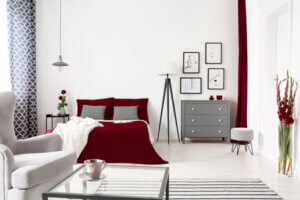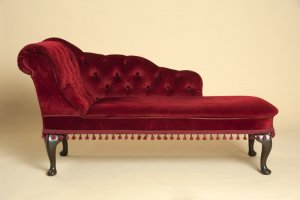The Color Wine in Interior Design

The color wine or burgundy in interior design generates different types of feelings, from serenity to elegance and strength. Needless to say, its presence can help you to better express your personality.
When you have a brand new floor with no colors on the wall, you want to apply a color that arouses pleasant sensations. An example would be the color burgundy, which reflects temperance in interior design.
This color is unusual in homes and is mostly used in the world of fashion, where it shows elegance, seriousness, and strength.
Here, we’re going to show you the possibilities that it offers you at an aesthetic level and why it’s a current trend.
The color wine in the living room

The living room is where this color works the best. First of all, you have to emphasize the aesthetic characteristics since it offers a feeling of tranquility, passion, strength, and warmth.
If you want harmony, you have to consider the walls as the frame for the room since they’ll help you coordinate the furniture.
On the other hand, the seating is one of the principal components that can be burgundy and become the main feature of the room. That’s why it’s best that the rest of the decor and the walls are different colors. Doing this will make the seating stand out more.
The perception that you get from the color wine is power combined with elegance and serenity
4 formulas to use in the bedroom

A bedroom is a private place which shows personality. The colors, decor, and furniture identify you. Therefore, the color wine will be better for people whose identity reflects character and self-confidence. Let’s look at some formulas:
1.When it comes to treating the walls, if you cover them completely it would be excessive. Maybe it’s preferable to place the wine color on the wall behind the headboard. Other walls can be white or a neutral color.
2. The bedspread is clearly the main focus of the decor in bedrooms. A wine color always makes it stand out and when it contrasts with the sheets or the headboard it really pops. The idea is that there is a distinct aesthetic.
3. One interesting element is pillows. Interior designers recommend bedding that is of light or neutral tones and having the pillows a different color. They will stand out much more this way. Two or three pillows would be enough.
4. Other common components are rugs next to the bed, which contrast with the floor and curtains. In addition, the curtains should be translucent, not opaque and the wine color should be dark.
Wine color in the bathroom

How can this color be in a bathroom? In the hospitality world, you can find it in many places, mainly in establishments that want to project an image of seriousness and elegance.
In your home, you can apply the same idea. The walls are the best backdrop in order to coordinate the colors, even with ceramic walls. In fact, you can create a balance with the fixtures in the bathroom along with walls that are left blank.
On the other hand, you can buy wine-colored towels or a wine-colored shower curtain. However, in these cases, the color is only used as a periphery.
Using the color wine in the entryway
Some houses in small towns use this color for the front door. At the same time, you can see the outside of houses painted this color. Basically, this offers a certain presence to the exterior of the house.
Once inside, the first area that you see is the entrance. There, you can apply the color wine to the walls, but you can also use it on a rug or a chair. It should appear in an anecdotal way. You shouldn’t overdo it, since this is a small space.
All cited sources were thoroughly reviewed by our team to ensure their quality, reliability, currency, and validity. The bibliography of this article was considered reliable and of academic or scientific accuracy.
- Egon Schuler, Josef: Color y decoración en el hogar, Gustavo Gili, 1968.








